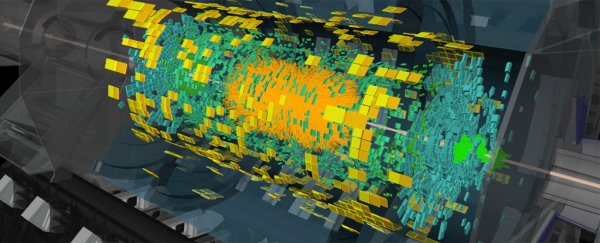After shutting down for two years to make substantial upgrades, the Large Hadron Collider (LHC) resumed operations earlier in 2015, and is now embarking on a new phase – colliding lead ions at an energy level twice that of any previous collider experiment.
Starting this month, scientists at the world's largest particle accelerator are running a trial with positively charged lead ions, which are lead atoms stripped of their electrons. Colliding these lead ions allows scientists at the European Organisation for Nuclear Research (CERN) in Switzerland to study a state of matter that existed shortly after the Big Bang, reaching a temperature of several trillion degrees.
"It is a tradition to collide ions over one month every year as part of our diverse research program at the LHC," said CERN chief Rolf Heuer. "This year however is special, as we reach a new energy and will explore matter at an even earlier stage of our Universe."
To study the state of matter directly after the Big Bang, you need to recreate a moment in time that was almost infinitesimally brief. The state of matter that's being quasi-simulated by CERN only existed in our Universe for a few millionths of a second, at a time when extremely hot and dense matter existed in a kind of primordial soup made up of particles called quarks and gluons.
By increasing the energy of the collisions in the new lead ion experiments – which is now possible thanks to the two years of work carried out on the LHC – scientists will increase the volume and temperature of quark and gluon plasma, enabling a more detailed and precise study of how matter existed in the fleeting conditions immediately after the Big Bang.
"There are many very dense and very hot questions to be addressed with the ion run for which our experiment was specifically designed and further improved during the shutdown," said one of the team, Paolo Giubellino. "The whole collaboration is enthusiastically preparing for a new journey of discovery."
In an opinion piece about the experiment, John Jowett, who runs CERN's heavy-ion program, said we should celebrate the breaking of a "new symbolic energy barrier", explaining that it might be a while before the next such frontier could be passed.
"[T]he concentration of so much energy into the tiny nuclear volume is enough to establish truly colossal densities and temperatures about a quarter of a million times those at the core of the sun," he wrote. "Heavy-ion collisions recreate the quark-gluon plasma, the extreme state of matter that is believed to have filled the Universe when it was only microseconds old… From the perspective of the early 1950s, the energies attained by the [LHC] would have seemed like science-fiction."
